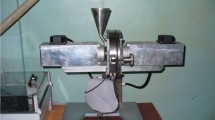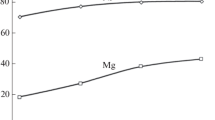Abstract
The studies concerning ore-dressing waste processing at the enterprises of the Kursk Magnetic Anomaly with the production of metals and building materials are described. About 1.8 billion tons of tailings have been stored there. A significant feature of deposit formation consists in the division of tailings by size and specific gravity using a water flow, since tailings are transported from the ore-dressing plant to the tailing pits by means of pipeline hydrotransport. The characteristics of tailings that originally showed wet magnetic separation of ferruginous quartzites taken from the Lebedinskoe deposit, as well as the methodology of investigation using a DESI-11 laboratory-scale disintegrator (Tallinn, Estonia), are presented. The authors have systematized the results for such tailings processing as: an agitation leaching in a percolator, agitation leaching after dry-state activation in a disintegrator, and reagent-driven leaching in a disintegrator. A regression analysis of experimental data has been performed, in which the iron extraction level depending on the values of variable factors inherent in the process is established. The used ore-dressing technologies are confined to the extraction limit, which results in the accumulation of processing tailings. The utilization of these tailings with traditional technologies is not profitable. However, the upgrading of ore-dressing processes could turn to be worthwhile with the use of hydrometallurgical and chemical technologies. It is shown that a promising direction in metal extraction from mining wastes consists in the combination of processing technologies based on the potentialities of the chemical ore-dressing and the activation in a disintegrator used in a joint manner. It has been determined that the mechanochemical activation of ore-dressing tailings in a disintegrator simultaneously with leaching can provide a significant increase in the extraction level, while the processing time is reduced hundredfold. Recommended technology could be in demand at mining enterprises with the prospects of switching for underground mining.



Similar content being viewed by others
REFERENCES
Golik, V.I. and Komashchenko, V.I., Ferruginous quartzite processing waste as a source of additional metal recovery and backfilling, Gorn. Zh., 2017, no. 3, pp. 43–47. https://doi.org/10.17580/gzh.2017.03.08
Golik, V.I., Komashchenko, V.I., Stradanchenko, S.G., and Maslennikov, S.A., Increasing completeness of subsoil use through deep utilization of coal enrichment waste, Gorn. Zh., 2012, no. 9, pp. 91–95.
Golik, V.I., Razorenov, Yu.I., Stradanchenko, S.G., and Khasheva, Z.M., Principles and economic efficiency of ore mining technology combination, Byull. Tomsk. Gos. Politekh. Univ., Inzh. Georesur., 2015, vol. 326, no. 7, pp. 6–14.
Komashchenko, V.I., Ecological and economic feasibility of mining wastes utilization for their processing, Izv. Tul’sk. Gos. Univ., Nauki Zemle, 2015, no. 4, pp. 23–30.
Kaplunov, D.R. and Radchenko, D.N., Design philosophy and choice of technologies for sustainable development of underground mines, Gorn. Zh., 2017, no. 11, pp. 121–125. https://doi.org/10.17580/gzh.2017.11.10
Epov, M.I., Yurkevich, N.V., Bortnikova, S.B., Karin, Yu.G., and Saeva, O.P., Analysis of mine waste by geochemical and geophysical methods (a case study of the mine tailing dump of the Salair ore-processing plant), Russ. Geol. Geophys., 2017, vol. 58, no. 12, pp. 1543–1552. https://doi.org/10.1016/j.rgg.2017.11.014
Krupskaya, L.T., Golubev, D.A., Rastanina, N.K., and Filatova, M.Yu., Reclamation of tailings storage surface at a closed mine in the Primorskii krai by bio remediation, Gorn. Inf.-Anal. Byull., 2019, vol. 2019, no. 9, pp. 138–148. https://doi.org/10.25018/0236-1493-2019-09-0-138-148
Volkov, E.P. and Anushenkov, A.N., Developing the technology of mine stowing with processing tailings based hardening blends, Izv. Vyssh. Uchebn. Zaved., Gorn. Zh., 2019, no. 7, pp. 5–13. https://doi.org/10.21440/0536-1028-2019-7-5-13
Lyashenko, V.I., Golik, V.I., and Dyatchin, V.Z., Storage of tailings in the form of a hardened mass in underground mined-out spaces and tailings facilities, Obogashch. Rud, 2020, vol. 2020, no. 1, pp. 41–47. https://doi.org/10.17580/or.2020.01.08
Lyashenko, V.I., Golik, V.I., and Dyatchin, V.Z., Increasing environmental safety by reducing technogenic load in mining regions, Izv. Vyssh. Uchebn. Zaved., Chern. Metall., 2020, vol. 63, no. 7, pp. 529–538. https://doi.org/10.17073/0368-0797-2020-7-529-538
Gavrishev, S.E., Kornilov, S.N., Pytalev, I.A., and Gaponova, I.V., Enhancing mine production efficiency through waste management, Gorn. Zh., 2017, no. 12, pp. 46–51. https://doi.org/10.17580/gzh.2017.12.09
Kayri, M., Predictive abilities of Bayesian regularization and Levenberg-Marquardt algorithms in artificial neural networks: a comparative empirical study on social data, Math. Comput. Appl., 2016, vol. 21, no. 2, art. ID 21020020. https://doi.org/10.3390/mca21020020
Modaihsh, A.S., Mahjoub, M.O., Nadeem, M.E.A., Ghoneim, A.M., and Al-Barakah, F.N., The air quality, characterization of polycyclic aromatic hydrocarbon, organic carbon, and diurnal variation of particulate matter over Riyadh city, J. Environ. Prot., 2016, vol. 7, pp. 1198–1209. https://doi.org/10.4236/jep.2016.79107
Ke, X., Zhou, X., Wang, X., Wang, T., Hou, H., and Zhou, M., Effect of tailings fineness on the pore structure development of cemented paste backfill, Constr. Build. Mater., 2016, vol. 126, pp. 345–350. https://doi.org/10.1016/j.conbuildmat.2016.09.052
Yuan, Y., Bolan, N., Prevoteau, A., Vithanage, M., Biswas, J.K., Ok, Y.S., and Wang, H., Applications of biochar in redox-mediated reactions, Bioresour. Technol., 2017, vol. 246, pp. 271–281. https://doi.org/10.1016/j.biortech.2017.06.154
Beiyuan, J., Awad, Y.M., Beckers, F., Tsang, D.C., Ok, Y.S., and Rinklebe, J., Mobility and phytoavailability of As and Pb in a contaminated soil using pine sawdust biochar under systematic change of redox conditions, Chemosphere, 2017, vol. 178, pp. 110–118. https://doi.org/10.1016/j.chemosphere.2017.03.022
Deng, D.Q., Liu, L., Yao, Z.L., Song, K.I., and Lao, D.Z., A practice of ultra-fine tailings disposal as filling material in a gold mine, J. Environ. Manage., 2017, vol. 196, pp. 100–109. https://doi.org/10.1016/j.jenvman.2017.02.056
Vrancken, C., Longhurst, P.J., and Wagland, S.T., Critical review of real-time methods for solid waste characterization: Informing material recovery and fuel production, Waste Manage., 2017, vol. 61, pp. 40–57. https://doi.org/10.1016/j.wasman.2017.01.019
Cheng, Y., Jiang, H., Zhang, X., Cui, J., Song, C., and Li, X., Effects of coal rank on physicochemical properties of coal and on methane adsorption, Int. J. Coal Sci. Technol., 2017, vol. 4, no. 2, pp. 129–146. https://doi.org/10.1007/s40789-017-0161-6
Paul, A., Murthy, V.M.S.R., and Prakash, A.K., Estimation of rock load in development workings of underground coal mines—A modified RMR approach, Curr. Sci., 2018, vol. 114, no. 10, pp. 2167–2174. https://doi.org/10.18520/cs/v114/i10/2167-2174
Burdzieva, O.G., Zaalishvili, V.B., Beriev, O.G., Kanukov, A.S., and Maisuradze, M.V., Mining impact on environment on the North Ossetian territory, Int. J. Geomate, 2016, vol. 10, no. 1, pp. 1693–1697.
Chen, T., Lei, C., Yan, B., and Xiao, X., Metal recovery from the copper sulfide tailing with leaching and fractional precipitation technology, Hydrometallurgy, 2014, vol. 147, pp. 178–182. https://doi.org/10.1016/j.hydromet.2014.05.018
De Oliveira, D.M., Sobral, L.G.S., Olson, G.J., and Olson, S.B., Acid leaching of a copper ore by sulphur-oxidizing microorganisms, Hydrometallurgy, 2014, vol. 147, pp. 223–227. https://doi.org/10.1016/j.hydromet.2014.05.019
Ghorbani, Y., Franzidis, J.-P., and Petersen, J., Heap leaching technology—Current state, innovations, and future directions: a review, Miner. Process. Extr. Metall. Rev., 2016, vol. 37, no. 2, pp. 73–119. https://doi.org/10.1080/08827508.2015.1115990
Mwase, J.M., Petersen, J., and Eksteen, J.J., A conceptual flowsheet for heap leaching of platinum group metals (PGMs) from a low-grade ore concentrate, Hydrometallurgy, 2012, vols. 111–112, pp. 129–135. https://doi.org/10.1016/j.hydromet.2011.11.012
Sinclair, L. and Thompson, J., In situ leaching of copper: challenges and future prospects, Hydrometallurgy, 2015, vol. 157, pp. 306–324. https://doi.org/10.1016/j.hydromet.2015.08.022
Vrancken, C., Longhurst, P.J., and Wagland, S.T., Critical review of real-time methods for solid waste characterization: Informing material recovery and fuel production, Waste Manage., 2017, vol. 61, pp. 40–57. https://doi.org/10.1016/j.wasman.2017.01.019
Wang, G., Li, R., Carranza, E.J.M., and Yang, F., 3D geological modeling for prediction of subsurface Mo targets in the Luanchuan district, China, Ore Geol. Rev., 2015, vol. 71, pp. 592–610. https://doi.org/10.1016/j.oregeorev.2015.03.002
Lyashenko, V., Khomenko, O., Topolnij, F., and Helevera, O., Substantiation of technologies and technical means for disposal of mining and metallurgical waste in mines, Technol. Audit Prod. Reserves, 2020, vol. 3, no. 3 (53), pp. 4–11. https://doi.org/10.15587/2706-5448.2020.200897
Stankevich, S.A., Dudar, T.V., and Svidenyuk, M.O., Stagnation of bagatoch radar interferometry for detecting the change of the Earth’s surface for the territory of uranium production in Ukraine, Ekol. Bezp., 2019, vol. 28, no. 2, pp. 18–23. https://doi.org/10.30929/2073-5057.2019.2.18-23
Author information
Authors and Affiliations
Corresponding authors
Additional information
Translated by O. Polyakov
About this article
Cite this article
Golik, V.I., Dmitrak, Y.V., Razorenov, Y.I. et al. Mechanochemical Technology for Iron Extraction from Ore-Dressing Tailings. Steel Transl. 51, 241–248 (2021). https://doi.org/10.3103/S0967091221040069
Received:
Revised:
Accepted:
Published:
Issue Date:
DOI: https://doi.org/10.3103/S0967091221040069




